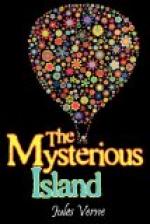“Eucalypti!” cried Herbert.
They were, in fact, those splendid trees, the giants of the extratropical zone, the congeners of the Australian and New Zealand eucalyptus, both situated under the same latitude as Lincoln Island. Some rose to a height of two hundred feet. Their trunks at the base measured twenty feet in circumference, and their bark was covered by a network of farrows containing a red, sweet-smelling gum. Nothing is more wonderful or more singular than those enormous specimens of the order of the myrtaceae, with their leaves placed vertically and not horizontally, so that an edge and not a surface looks upwards, the effect being that the sun’s rays penetrate more freely among the trees.
The ground at the foot of the eucalypti was carpeted with grass, and from the bushes escaped flights of little birds, which glittered in the sunlight like winged rubies.
“These are something like trees!” cried Neb; “but are they good for anything?”
“Pooh!” replied Pencroft. “Of course there are vegetable giants as well as human giants, and they are no good, except to show themselves at fairs!”
“I think that you are mistaken, Pencroft,” replied Gideon Spilett, “and that the wood of the eucalyptus has begun to be very advantageously employed in cabinet-making.”
“And I may add,” said Herbert, “that the eucalyptus belongs to a family which comprises many useful members; the guava-tree, from whose fruit guava jelly is made; the clove-tree, which produces the spice; the pomegranate-tree, which bears pomegranates; the Eugeacia Cauliflora, the fruit of which is used in making a tolerable wine; the Ugui myrtle, which contains an excellent alcoholic liquor; the Caryophyllus myrtle, of which the bark forms an esteemed cinnamon; the Eugenia Pimenta, from whence comes Jamaica pepper; the common myrtle, from whose buds and berries spice is sometimes made; the Eucalyptus manifera, which yields a sweet sort of manna; the Guinea Eucalyptus, the sap of which is transformed into beer by fermentation; in short, all those trees known under the name of gum-trees or iron-bark trees in Australia, belong to this family of the myrtaceae, which contains forty-six genera and thirteen hundred species!”
The lad was allowed to run on, and he delivered his little botanical lecture with great animation. Cyrus Harding listened smiling, and Pencroft with an indescribable feeling of pride.
“Very good, Herbert,” replied Pencroft, “but I could swear that all those useful specimens you have just told us about are none of them giants like these!”
“That is true, Pencroft.”
“That supports what I said,” returned the sailor, “namely, that these giants are good for nothing!”
“There you are wrong, Pencroft,” said the engineer; “these gigantic eucalypti, which shelter us, are good for something.”
“And what is that?”
“To render the countries which they inhabit healthy. Do you know what they are called in Australia and New Zealand?”




